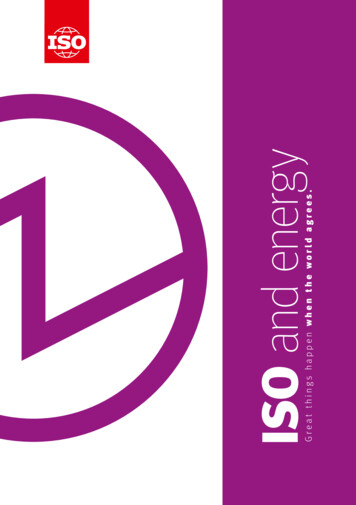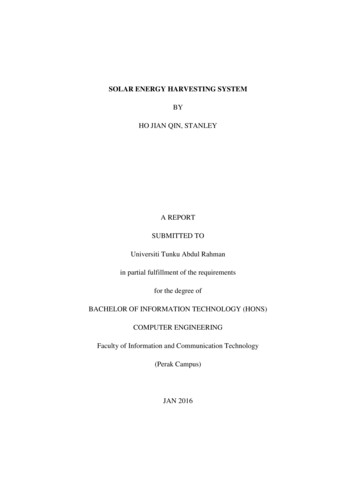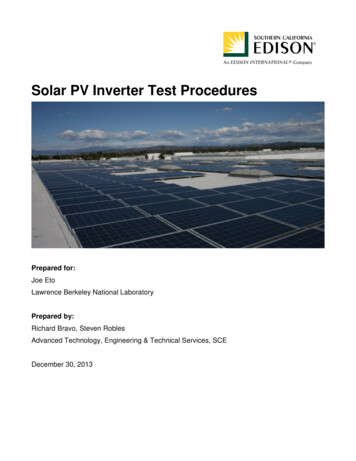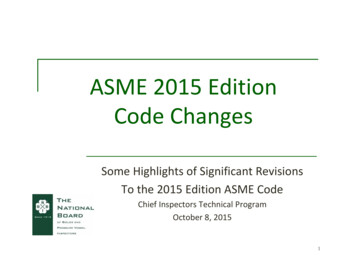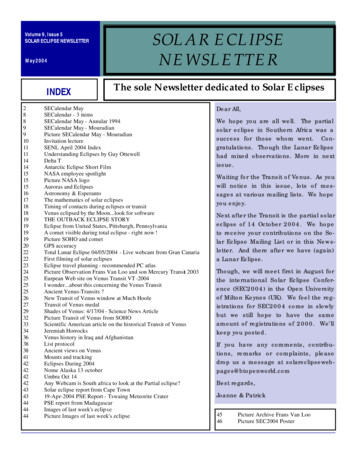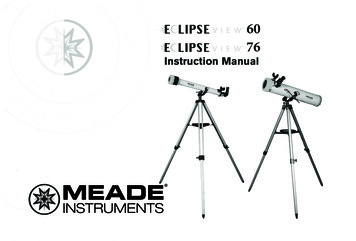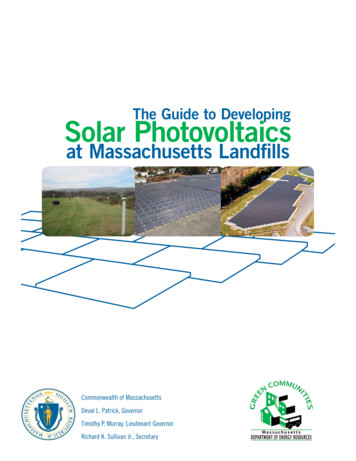
Transcription
The Guide to DevelopingSolar Photovoltaicsat Massachusetts LandfillsCommonwealth of MassachusettsDeval L. Patrick, GovernorTimothy P. Murray, Lieutenant GovernorRichard K. Sullivan Jr., Secretary
Table of ContentsAcknowledgments .Introduction . 1About DOER .1About Nexamp .1Module #1: How Does Solar Electricity Work? . 2The Basics .2How Is Electricity Production from a PV System Maximized? . .2What Hardware Is Included? . .4Module #2: What Incentives Are Available for Solar? . 5Solar Renewable Energy Certificates .5Net Metering .5Federal Investment Tax Credit .6Accelerated Depreciation / Bonus Depreciation . .6Summary .6Module #3: Considerations for Designing and Developing Solar on a Landfill . 7Getting Started: Feasibility Assessment . .7How Does Construction & Operation of Solar PV Affect Landfill Management? .9PV Design Considerations at Landfills .11Construction Considerations .11Post-Closure Use Maintenance Considerations . .11Module #4: What Ownership Structures and Strategies Can We Use to Develop a Landfill Solar PV Array? . .13Typical Development Tasks .13Municipal Ownership .13Land Lease .14Power Purchase Agreement and Credit Purchase Agreement .16Performance Based Revenue Via Power Purchase/Net Metering Credit Purchase Agreements . .16Hybrid Land Lease and CPA/PPA Revenue Structure . .17Module #5: Development and Design Considerations .18What Else Do I Need to Know about Permitting? .18Permitting Fees .18Interconnection .20What Should I Be Looking for in System Design? . .21Module #6: What Is the Project Cost Profile? .22Design and Engineering .22Permitting . .22Interconnection .22Construction and Equipment .23Operations & Maintenance .23System Monitoring .23Insurance .23Local Taxation .23General Property Tax .23Module #7: How Do We Manage the Procurement Process? .25What Does a Complete and Thorough Solicitation Include? .25How Do I Select the Right Vendor for My Project? . .25Which Procurement Process Is Right for My Municipality? .26Prevailing Wage .29prepared and designed this guide using solar power.
Module #8: What About Long-term System Management? .31Operations & Maintenance .31Equipment Warranty .31Monitoring .31End of Life . .32Buyout Provisions .32What Are My Next Steps? . . 33Case Study #1: Brockton Brightfields . . 34Case Study #2: Easthampton Landfill Solar PV Array .35Appendix A: Project Checklist .36Appendix B: Additional Details on Solar Renewable Energy Certificates . .37Appendix C: Additional Details on MassDEP Permit Requirements . 38Notes .41AcknowledgmentsThe Massachusetts Department of Energy Resources (DOER) would like to acknowledge the MassachusettsDepartment of Environmental Protection, the Massachusetts Attorney General’s Office, the MassachusettsDepartment of Revenue, and the Massachusetts Inspector General’s Office, all of whom have provided guidanceand support this project.In particular, the following individuals provided significant guidance and support (in alphabetical order):Natalie Andrews, Jim Barry, Gary Blau, Dwayne Breger, Kelly Brown, Mark Dakers, Paul Edmond, Courtney FeeleyKarp, Helen Flaster, Eric Friedman, Kurt Gaertner, Mike Judge, Meg Lusardi, Eileen McHugh, Brian O’Donnell,Mark Sylvia, and Sarah Weinstein.In addition, DOER would like to acknowledge the project advisors and external reviewers who provided significantguidance during the development and review of this publication. These individuals provided time and expertise thathelped ensure that this guidebook is thorough and informative for its users. Special thanks to:Mayor Michael A Tautznik, City of EasthamptonOrlando Pacheco, Town Administrator, Town of LancasterLura Matthews, United Stated Environmental Protection AgencyShea Jones, United Stated Environmental Protection AgencyKatie Brown, United Stated Environmental Protection AgencyDavid Andrews, P.E., Senior Geoenvironmental Engineer, TRC SolutionsPhilip Hall, Director of Marketing, Borrego Solar Systems, Inc.
IntroductionThere has never been a more opportune time for municipalities to develop solar photovoltaic (PV) systems onlandfill sites.» Municipalities are seeking additional, creative ways to leverage underperforming assets to save money orgenerate new revenues.» Massachusetts has a robust market for Solar Renewable Energy Certificates (SRECs) generated by solar PVproduction.» Investor-owned utilities in Massachusetts allow net metering, which allows projects to capture retail rates forelectricity produced by qualifying renewable energy projects.» Electricity produced by an onsite solar PV system can provide a hedge against volatile energy prices.This guidebook has been published to help municipal officials identify, evaluate, and pursue opportunities toharness the sun’s power to generate electricity and revenue from undeveloped landfill space. Topics coveredinclude: physical requirements of PV systems; PV system economics; landfill considerations; public procurement;and PV system development, design, and installation.This guidebook was prepared by Nexamp, Inc. on behalf of the Massachusetts Department of Energy Resources (DOER).About DOERDOER’s mission is to create a cleaner energy future for the Commonwealth, economically andenvironmentally, including:» achieving all cost-effective energy efficiencies;» maximizing development of cleaner energy resources;» creating and leading implementation of energy strategies to assure reliable supplies and improve relative cost;and» supporting clean tech companies and spurring clean energy employment.DOER is an agency of the Massachusetts Executive Office of Energy and Environmental Affairs (EEA).About NexampAs a leading solar independent power producer, Nexamp develops, builds, owns, and operatesdistributed and utility-scale solar projects for private and public sector clients and partners.Nexamp delivers integrated solutions—from project development and financing through construction and assetmanagement—to ensure that our clients and partners maximize the value of their solar energy investments. The Guide to Developing Solar Photovoltaics at Massachusetts Landfills
Module #1: How Does Solar Electricity Work?The BasicsSolar photovoltaic (PV) systems convert sunlight directlyinto electricity. When sunlight strikes the semiconductormaterial in a solar cell electrons are freed and begin toflow. This flow of electrons creates an electric current,or electricity. The more intense the sunlight striking thepanel, the greater the amount of electricity produced.The solar cell is the basic block of PV technology. Solarcells are aggregated to form a PV module or panel. Oneor more modules are wired together into strings, orgroups of panels. Strings are connected to an inverter,which converts the direct current (DC) producedby panels into the alternating current (AC) used byelectrical devices in the United States. Figures 1, 2,and 3 show some typical solar cells, panels,and inverters.customer might see an average monthly use of 500750 kWh, and the average residential system of 3 kWproduces 3,000-4,500 kWh per year.A good rule of thumb when sizing systems is that 1kilowatt of PV requires 100 square feet of unobstructedarea for a pitch roof, and up to 130 square feet foropen land. For ground-mount systems, each megawatt(MW) of installed capacity typically needs 4-5 acres.Larger systems are somewhat more cost effective thansmaller systems due to economies of scale associatedwith system design, installation, and interconnection.How Is Electricity Production from aPV System Maximized?ShadingElectricity production from PV systems is primarilya function of PV panel orientation, tilt, and DC toAC conversion losses. These factors are describedin greater detail below. The capacity of a system isdescribed in terms of the instantaneous amount ofpower it can produce, expressed in watts, or kilowatts(kW). In Massachusetts, 1 kW (DC) of PV capacity, atthe optimal orientation and tilt for maximum annualproduction, can produce between 1,000 and 1,500kilowatt-hours (kWh) of electricity annually. Theseproduction estimates account for the fact that the sunshines more in the summer than in the winter, and notat all at night. As a point of comparison, a residentialThe amount of sunlight, measured as insolation, thata PV system experiences impacts overall systemperformance. PV system design should avoid placingsolar panels in areas that are shaded at any pointduring the day in order to maximize insolation. Inparticular, it is important to maximize solar accessfrom May-September, when production is highest. Theonly exceptions are up to ninety minutes after sunrisein the morning and ninety minutes before sunset inthe afternoon. The most common features that causeshading are trees, buildings, telecommunicationsstructure, or rooftop HVAC systems. Ground-mountsystems risk shading from grasses and other vegetation.Figure 1: Solar Cell (photo: US Department of Energy / NREL)Figure 3: 500-kilowatt Inverter (photo: Solectria Renewables)Figure 2: Solar Module (photo: US Department of Energy / NREL)Massachusetts Department of Energy Resources
Figure 4: Massachusetts-manufactured Panel Claw Mounting System(photo: Nexamp)Figure 5: High-density Pre-cast Concrete System (photo: Solar FlexRack)Well-designed PV systems avoid panel-to-panel shadingexcept near sunrise or sunset. The modules will alsoface seasonal snow coverage, which will vary dependingon the height and tilt of modules, depth of snowcoverage and other weather conditions (e.g., a slightthaw can create icing conditions that prevent snowfrom sliding off the modules). While snow typicallymelts and slides off tilted modules, there may be shortperiods when the array is covered and the array does notproduce electricity.system at a 5-degree tilt can maximize summerproduction, and still achieve more than 80 percentof the production achieved by a 36 degree tilt angle.Optimizing tilt and production may provide benefits tocustomers that for example pay higher electricity ratesin the summer months or at certain periods of the day.Similarly, there may be opposing design considerationsfor a maximum tilt angle (36 degrees) and a tilt anglecloser to 10 or 20 degrees. Systems with a higher tiltangle require more spacing between rows to preventpanel to inter-panel shading,Orientationand may have higher structuralSolar PV arrays must be designedengineering requirements inPV systems are oriented in atomeetsite-specificconditionsorder to comply with statesouth-facing direction in orderwindload requirements. Whileand to optimize production.to maximize power production.a36-degreetilt maximizesFor roof-mounted projects, itannual production per kW ofmay be possible to get up toinstalledcapacity,alessertilt of 20 degrees would95 percent of optimal production even if the roof facesprovideanannualproductionof nearly 95 percent ofSoutheast or Southwest. For ground-mounted arrays,that maximum, and would allow for the installation ofsystem design should optimize the orientation to bemore modules in the same area. Therefore, pursuing afacing as close to true south as possible. Note: Truelargerproject with a smaller tilt angle may be more costsouth differs from magnetic south in Massachusetts.advantageous for some projects.TiltThe tilt angle of a PV system is another key variable thatimpacts power production. Maximizing generation basedon tilt angle can be a very site-specific and projectspecific exercise. PV layout and tilt angles can beoptimized to achieve different goals, so understandingproject objectives at an early stage can help guidethe design process. For example, at Massachusettslatitudes, a tilt angle of 36 degrees will typicallymaximize annual generation. However, installing a TrackersMost New England PV installations rely on a “stationary”design, meaning the systems do not track themovement of the sun. However, systems do exist thattrack the path of the sun to increase production, butthe added cost of installing and maintaining a trackingsystem often outweighs the net increase in systemproduction realized by a tracking system in NewEngland. To maximize the production of electricity, theThe Guide to Developing Solar Photovoltaics at Massachusetts Landfills
design of individual PV installations must consider(and optimize) the factors of shading, orientation, andmodule tilt.What Hardware Is Included?A typical solar PV system consists of three primarycomponents: solar panels; inverters; and a mountingsystem. Different options are available for each of thesecomponents, and it is important to choose the optionsthat best fit the site conditions.a high density pre-cast concrete system (see Figure5 for a system that uses pre-cast concrete blocks tohold modules and the racking in place), and a drivenpile mounting structure (see Figure 6). The mountingsystem must be optimized for specific site concerns,including lift, snow shedding, wetlands, water table, andpermitting issues, in addition to subsurface issues suchas landfill, stone, or other potential impediments. Fortypical landfill sites, the ideal mounting system is morelikely to be a non-penetrating system than a systemwith ground penetrations.Roof mounted PV arrays can be developed to meet arange of site-specific conditions. Common mountingtypesinclude non-roof penetrating systems for standingSolar modules vary in size (dimensions), DC capacity(amount of instantaneous DC energy produced in Watts), seam metal roofs and rubber membrane roofs, whileother mounting solutions may rely on roof penetrations.efficiency (amount of energy produced per squareThesolar industry has developed solutions to addressunit area, typically listed as Watts/square meter), andlocation of manufacture. Panels typically come with a 5- most scenarios, including flat and pitched roofs, andyear minimum workmanship warranty, and a production metal, rubber, and other roof material types.guarantee of 90% of maximum rated capacity after 10Qualified integrators and developers should be able toyears, and 80% of maximum rated capacity after 25provide guidance on appropriate mounting solutions foryears.a diversity of sites.ModulesInvertersAdditional System ComponentsInverters are the heart of a well-built PV array. Invertersconvert DC electricity produced by the solar panelsinto AC electricity to be transmitted to the grid. Typicalinverters come with a minimum 5 year warranty,although 10 years is quickly becoming the industrystandard.Mounting SystemGround mounted PV arrays typically use one of threecommon mounting structures, a low density concreteblock ballasted system (see Figure 4 for a system thatsits on top of the ground without penetrating the soil),In addition to the three primary components highlightedabove, a PV array will require additional hardwareincluding DC wiring, combiner boxes, disconnects,meters, transformers, and AC wire. The placement ofadditional equipment must be optimized based on soilconditions, footprint, and other site-specific concerns.Many municipalities will also choose to install a dataacquisition system with a web-based interface sothat municipal officials, citizens, schools, and otherstakeholders can view information about the solar arrayand the power it is generating.Figure 6: Driven Pile Mounting Structure(photo: Solar FlexRack)Massachusetts Department of Energy Resources
Module #2: What Incentives Are Available for Solar?Various state and federal policies are available toimprove the economics of installing and owning largescale solar PV arrays. This module outlines some ofthese key incentives and policy mechanisms, someof which apply to municipal projects, while othersapply only to systems owned by for-profit entities. Theincentives available for projects owned by for-profitsare indirectly available to municipalities through athird-party ownership model, explained in more detail inModule #4.The list of incentives that follows is not meant tobe comprehensive, but instead to highlight the keyconsiderations for embarking on a solar PV project inMassachusetts.Note: The information provided here is for generalinformation only, and should not be relied upon withregard to a specific project without consultation withtown counsel.The Solar Carve-out creates a market demand forSRECs. The advent of SRECs creates an additionalpotential revenue stream for qualified solar projects.SRECs have a minimum value of 285/MWh and aprice ceiling of up to 550/MWh, depending on marketconditions.The owner of a solar PV array can sell SRECs generatedby the project directly to the retail electric suppliers orwork with a broker who will help them identify buyersof those SRECs. SRECs can be sold each quarter atspot market prices, or projects can enter into longterm purchase agreements that provide assurance forlong-term system revenue. More detail is included inAppendix B.Net MeteringCustomers of Massachusetts’ investor-owned utilities,National Grid, NSTAR, Western Massachusetts ElectricCompany, and Unitil, have the option of selling netSolar Renewable Energy Certificatesexcess electricity generation from a qualifying solarproject via net metering. Net metering allows a projectIn 2010, as outlined by the Massachusetts Greenhost to offset its electricity usage with electricityCommunities Act of 2008 and in support of Governorgenerated on-site, reducing the amount of electricityDeval Patrick’s goal ofthe customer must buy from the distribution company.installing 250 MW of solarFor customers that produce more electricity than theyIn support ofgeneration capacity byconsume in any given month, credits accrue and can2017, the MassachusettsGovernor Patrick’sbe carried forward and applied to future months’ bills.Department of EnergyCredits also may be transferred to another customergoal of installingResources establishedof the same distribution utility as long as they are250 MW of solarregulations that promote solar within the same service territory and ISO-NE (theinstallation and generationPV by 2017, theregional electricity grid operator) load zone. The valuein Massachusetts, within theSolar Renewableof each kilowatt-hour is worth more as a net-meteredCommonwealth’s existingcreditunder this policy than if the kWh was sold toEnergy Certificate,Renewable Portfolio Standard. the utility grid at the clearing price. Additional detailor environmentalUnder the “Solar Carveon transaction types for selling net metering credits isout,” Massachusetts’s retailattribute of theincluded in Module #4.electric suppliers are requiredenergy producedto buy Solar RenewableIn Massachusetts, there are several categories of netby the solar array,Energy Certificates (SRECs)metering facilities. “Class I” facilities are generallycan be sold at afor an increasing portiondefined as systems up to 60 kW in capacity. “ClassoftheelectricitytheyII”facilities are generally defined as systems greaterpremium.than 60 kW and up to 1 megawatt (MW) in capacitydeliver each year. SRECsare created as qualifyingthat generate electricity from agricultural products,solar installations generatesolar energy, or wind energy. “Class III” facilities areelectricity. One SREC is created for every 1,000generally defined as systems greater than 1 MW and upkWh (1 MWh) of electricity generated by a qualifyingto 2 MW in capacity and that generate electricity fromagricultural products, solar energy or wind energy.Massachusetts PV array. The Guide to Developing Solar Photovoltaics at Massachusetts Landfills
Under current net metering rules, net metered facilitiesmust be located behind a customer’s meter, butonly a minimal amount of onsite electricity load isrequired. A legislative amendment enacted in late2010 established a new definition for “a net meteringfacility of a municipality or other governmental entity.”As provided for in the legislation, this category of netmetered facility must be either Class II or Class IIIand must be owned by a municipality or governmentalentity, or the entity must use all of the facility’s output.The legislation also capped the aggregate amount ofcapacity a municipality or other governmental entitymay net meter at 10 MW.Customers of Municipal Light Plant Departments(MLPs) may be eligible for net metering and areencouraged to contact their local MLP to learn moreabout what options are available to them.Federal Investment Tax CreditQualified solar PV projects are eligible for a federalinvestment tax credit of up to 30% of eligible systemcosts, if installed by December 31, 2016. The taxcredit can be taken and applied against the federaltax obligation of a for-profit entity. The 30% tax creditwill sunset at the end of 2016 and revert to a 10% taxcredit which has no expiration date.For more information, please /US02F.htmAccelerated Depreciation /Bonus DepreciationUnder the federal Modified Accelerated Cost RecoverySystem (MACRS), businesses are able to recoverinvestments in eligible property through depreciationreductions. Solar PV is specifically eligible for a 6year accelerated depreciation schedule if the systemis installed by 2016. Moreover, for systems installedin 2012, bonus depreciation is available. For systemsinstalled in 2012, businesses can depreciate 50%of the value of the system in the 2012 tax year, withthe remaining value depreciated over years 2-5 of theproject lifetime based on the MACRS schedule.For more information, please visithttp://www.irs.gov/irb/2011-16 IRB/ar10.htmlNote: Massachusetts does not allow the deduction atIRC § 168(k) for bonus depreciation. A Massachusettstaxpayer that claims bonus depreciation under IRC168(k) for federal purposes must calculate a separatedepreciation schedule for purposes of claimingdepreciation on the Massachusetts tax return. SeeTechnical Information Release 03-25, DepreciableBusiness Assets; Modifications for Decoupling fromFederal Bonus Depreciation.Link to Massachusetts Business Related e information about these incentives can befound online at: http://www.dsireusa.org. The site isperiodically updated to include new information andchanges in incentives. For example, there are federaltax credit bond offerings that are available whenauthorized by Congress, such as Clean RenewableEnergy Bonds and Qualified Energy Conservation Bonds.Massachusetts Department of Energy Resources
Module #3: Considerations for Designing andDeveloping Solar on a LandfillSolar PV development on landfills offers a significantopportunity for municipalities in Massachusetts. TheCommonwealth has more than 490 landfills, 466of which are now inactive or closed. More than 40have received post-closure use permit approvals fromMassDEP, including 20 projects with solar PV specificuses totaling more than 42.8 MW.Although not every landfill is suitable to host a solarPV system, municipal landfills with advantageoussite characteristics may provide an opportunity forcities and towns to generate revenue from otherwiseundevelopable land. Table 1 (left) outlines some of thekey advantages and challenges associated with sitingsolar PV projects on landfills.If a landfill was not closed and capped in a
Electricity produced by an onsite solar PV system can provide a hedge against volatile energy prices. This guidebook has been published to help municipal officials identify, evaluate, and pursue opportunities to harness the sun’s power to generate electricity an



